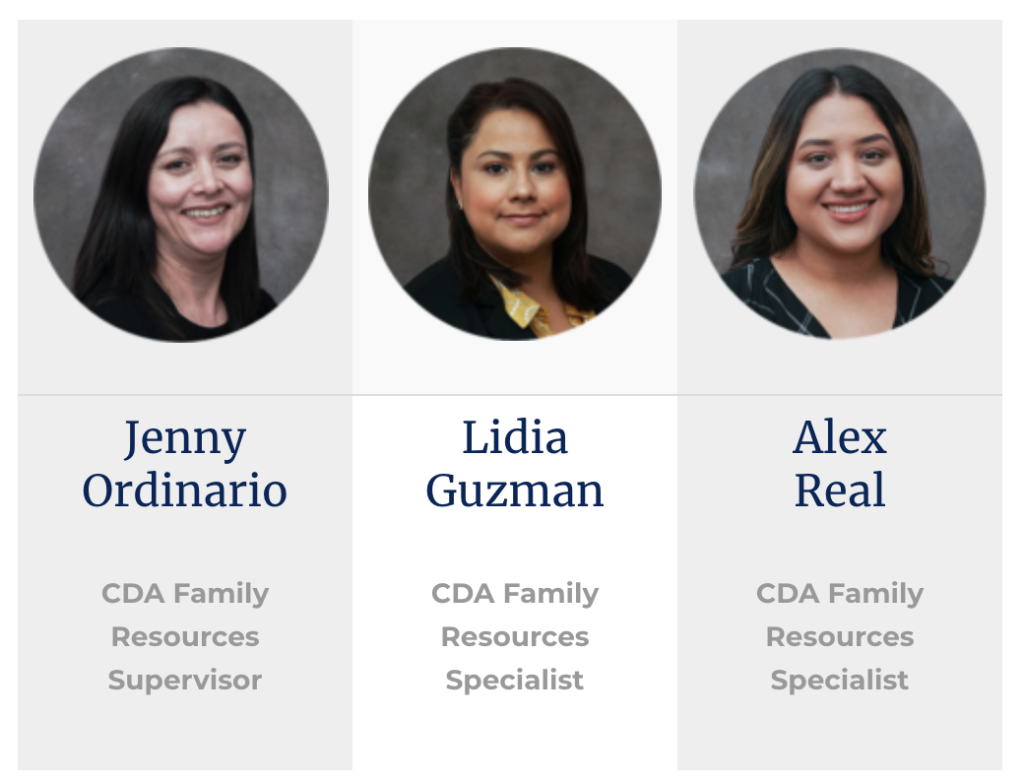I hope your 2020 has been off to a great start. I can’t believe we are already in March. I am excited to share and welcome to CDA’s Family Resources team, Lidia Guzman and Alexandra “Alex” Real. Both, Lidia and Alex have a professional background in the social services field and a passion for supporting CDA’s vision of creating positive change.
The goal for the Family Resource team is to ensure that we continue to support CDA’s mission, to encourage and support the success and well-being of children, families, and childcare community by maintaining a resource library, connecting families to resources and appropriate services, and coordinating programs that promote strong families. You can reach our Family Resource Specialists at both our Kearny Mesa and Bonita office.
With the holidays past us, many of us are still feeling the financial pressures caused by holiday spending. Setting financial goals and teaching children about money early in life will help them develop a strong foundation for healthy financial habits in the future.
Money Matters for Children
Decisions, such as financial ones, are usually influenced by various sources, such as our culture, family, ethnicity, community, socio-economic status, and even religion. As parents and caregivers, the choices we make will usually influence and affect our children. Financial stress can be extremely overwhelming, especially given the consumer society we live in. Children and adolescents are constantly being bombarded by social media and popular culture and the style of living they see is usually very unrealistic. Don’t wait to teach your children about money and developing healthy financial habits. Here are some tips to consider:
1. Securing your child’s future
Part of developing a strong and healthy financial future for your child is making sure that their personal information stays secure. The best way to protect them from identity theft is teaching them about online safety as early as they learn to begin to use online devices, such as computers or mobile phones. It is also important that you take control and limit access, including sharing information on social media outlets where identity thieves, hackers, and scammers are known to gather pieces of information for the purpose of committing fraud.
2. Talking about money
Children naturally like to learn and ask a lot of questions. A great way to teach your child about money is to engage them in the process of understanding how money works and its value. Helping your child learn the difference between needs and wants will also help them to prioritize how they use their money and spend it. For example, make a shopping list with your child of items you need or want to buy for the family, such as food, clothes, toys, crayons, and so on. Ask your child to identify the needs and wants, and prioritize them in order of importance.
3. Creating a budget
Creating a budget or spending plan is a useful tool to help us learn and decide how much money we can spend and how to spend it. Creating a budget and sticking to the plan will help us set limits and to stop us from overspending and running out of money. The same applies when teaching your child about spending plans. For example, give your child a specific amount of money and ask him or her to help find items needed, encourage comparison-shopping while staying within the budget.
4. Setting goals
Teaching your children to set goals will help them focus on the things they want to achieve. For example, putting aside a certain amount of money for a specific purpose such as buying a favorite toy or a special outing. Create a goals chart and share your short or long term goals, and steps on how you plan to meet them. Help your child do the same and track progress together.
5. Using a clear jar to save
A fun way to get children excited about saving is using a clear jar. The traditional piggy bank doesn’t allow children to see their money grow. Also, when your child decides he or she wants to buy something, have them use their money from their savings jar to allow them to also see their money decrease.
6. How money is earned
A great way to teach children to appreciate money is by letting them earn it. Set up a list of age-appropriate assignments and payments for different tasks. Make sure you pay based on your agreement.
7. Lead by example
Parents are a child’s first teacher. When it comes to teaching your children about money, the best way is to set an example. Avoid arguing about money or making impulse purchases. Your child is far more likely to develop habits based on our own actions.
Financial Literacy Resources
OnGuardOnline
https://onguardonline.gov
OnGuardOnline is a great resource to learn more about online safety.
Federal Deposit Insurance Corporation (FDIC) – Money Smart
https://www.fdic.gov/consumers/consumer/moneysmart/
Local campaigns distribute toys as Christmas gifts to needy children.
SDCCU Biz Kid$
https://www.sdccu.com/about/community/sdccu-biz-kids/
The San Diego County Credit Union (SDCCU) has partnered with the San Diego County Office of Education and Live Well San Diego to provide educational tools that teach kids about money and business.
Junior Achievement
https://www.juniorachievement.org/web/ja-usa/home
JA’s volunteer-delivered, K-12 grade programs foster work-readiness, entrepreneurship, financial literacy skills, and use experiential learning to inspire students to dream big and reach their potential.
San Diego Financial Literacy Program
https://www.sdflc.org/
The program provides free financial literacy services throughout San Diego County.
I hope you find these tips and resources helpful in teaching your children about money matters. Please remember that the Family Resource team is here to assist you with any resources or referrals you may need. We look forward to working with you.
I hope you find these tips and resources helpful in teaching your children about money matters. Please remember that the Family Resource team is here to assist you with any resources or referrals you may need. We look forward to working with you.






